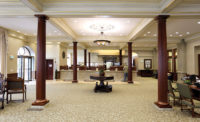The past couple of decades have seen revolutionary changes in the countertop industry. The shift to CNC equipment has made the impossible possible, and in a fraction of the time and cost. The pace of change today is no less staggering, and it’s important not only to understand what’s changing, but to also understand the implications of that change.
Robotic sawjets
The introduction of robotic sawjets into the countertop industry has provided some new options depending on the application for which they are needed. However, robots may not be the best solution for every application, so it’s important to understand the problem you’re trying to solve and what tool is best for the job.
For example, a robotic sawjet can perform many of the same operations as a more traditional bridge-style sawjet, but they often take up less space, and, let’s face it, they’re pretty cool. Robots are pick and place machines and excel at repetitive motion work.
For all their flair and efficiency though, they are not as accurate as a bridge-style sawjet, which may be an important consideration. And, if you’re considering an investment in new equipment, this distinction will be important to weigh to make sure that you get the right tool for the job.
The benefits of a robotic sawjet
Minimal footprint
Robotic sawjets tend to have a smaller footprint. This can be a big advantage for small shops, or for shops that need more capacity and are unable to expand. If space is a concern in your shop, a robotic sawjet or mono block bridge-style sawjet would be a great option.
Speed
A robotic sawjet’s out-of-cut speed is typically faster than that of a bridge-style sawjet. These small increments of time savings may not seem like much, but, over the course of a full program, these seconds will add up.
Maintenance
Though maintenance is necessary for all machines, a robot benefits from fewer maintenance needs due to the design of the robotic arm. It will still require periodic oil changes and other routine maintenance, such as intensifier maintenance.
Awe factor
You don’t need to be a sci-fi enthusiast to appreciate the flair of a robot. Their movements are fluid and swift, which adds a different dynamic to your shop. What’s more, for those of you who use a tour of your shop as part of your sales process, this could be a marketing advantage. Robots add an element of technological sophistication that will stand out for your customers and may give your customers additional confidence in your shop’s capabilities.
Key considerations when evaluating robotics
A robot may or may not be the best solution for everyone. But how do you know if it’s right for you? There are a few key considerations that you need to be aware of in order to appropriately answer this question.
Out of cut movements
“Out of cut” movements are positioning movements a machine makes between cuts. The amount of time spent on these types of movements will vary from one machine to the next, and fewer is best. Any time your machine is not cutting is time you’re not producing. And when time is money, unproductive time is a missed opportunity. These seemingly insignificant gaps in your production process are lost efficiencies. Whether you’re considering a bridge-style sawjet or a robotic sawjet, be sure that you understand how quickly your machine can cut to your required specifications.
Accuracy acceptability
For many applications, a robotic sawjet will perform well; however, there are some applications that may require a greater level of accuracy than a robotic sawjet is able to provide. The weight of a blade mounted to the end of a robot arm will invariably provide some instability as the arm fully extends, which means that you either shrink your usable work envelope, or you accept greater tolerances in the cut.
Alternatively, if you require a more exact cut, with stricter tolerances, a bridge-style sawjet may be a better option. The stability provided by the bridge design will result in a more exact cut, which may be necessary on some jobs, work pieces or when moving parts directly to finish.
In some cases, you can achieve the same level of accuracy by cutting on multiple machines. This would seem to be the best of both worlds – the speed of the robot combined with the finishing accuracy of a router. This isn’t without downsides though; additional tooling costs, the energy and maintenance costs of running multiple machines and labor wasted on moving cut parts between machines are additional considerations when processing on multiple machines.
Blade versus jet ratio
At first glance, the decision whether to use a blade or waterjet to cut may seem obvious. The jet does a lot of the corners and complex or tight cuts already, so why not use it for all the cuts? Especially when not all robots are able to blade cut at the edges of the table and are reliant on the jet for cutting at the corners of the work envelope anyway.
While it’s possible to use the waterjet for processing the entire project, you will not be using your resources optimally. It is important to understand the cutting capabilities of the machine, as well as the costs associated with waterjet cutting — most notably the cost of consumables and slower processing speeds. These costs will vary from machine to machine, and it will be important to evaluate these additional costs when making your decision.
Another important consideration is the reach of the robotic arm. The greater the reach, the greater your work envelope with the blade, which means you can limit how often you cut with a waterjet. This will enable you to minimize your consumable costs and process jobs more efficiently. In summary, processing as much of the program with the blade will provide the greatest efficiency at that lowest operational cost.
New tomorrows
Technology continues to change our industry. When considering adding any machine to your shop, it’s important to carefully evaluate all your options. With a sawjet, it’s important not to make your decision solely based on the appearance and technological swagger of the machine, and it’s equally important not to ignore the obvious benefits of such a machine.
What’s most important is to understand what you need from the machine. How will it fit in your shop – not just in terms of physical layout, but how well does it complement your overall machine lineup? Can it perform the way you need it to? Will it require other machines for finishing work? Do you already have these other machines or will you need to acquire them? There are numerous considerations, and I encourage you to view your shop holistically as you weigh them all.
Though our industry has undergone dramatic changes in the last couple of decades, the rate of change has done little to slow. These are exciting times for our industry, and as technology changes how we work, so too will we need to adapt. But these changes bring benefits in the form of improved productivity and greater efficiency. There are many changes coming. Our job is to embrace it and determine how best to leverage the potential opportunities.
Column co-author- Chad Nichols






